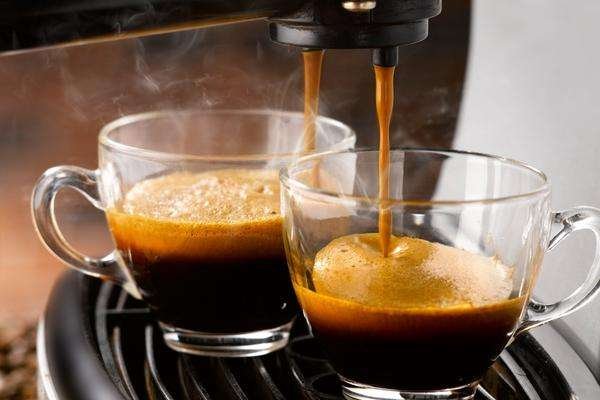Novices might think that all espresso drinks are created equal, but there is actually a big difference between ristretto and espresso. Ristretto vs espresso – what are the differences? This article will teach you the key differences between these two coffee drinks, so you can order the one you like best next time you’re at the cafe. Keep reading to learn more!

What is Ristretto?
Ristretto is a type of coffee that is made with less water than a regular espresso. As a result, it has a higher concentration of coffee grounds and a stronger flavor. Ristretto is typically served in smaller cups than regular espresso, often with less foam on top.
Some coffee enthusiasts believe that ristretto has a more complex flavor than regular espresso, as the higher concentration of coffee grounds allows more of the coffee’s natural oils to be extracted. Ristretto is also said to have a smoother texture, as the smaller amount of water produces a less bitter taste.
Whether you’re looking for a more intense flavor or a richer texture, ristretto may be worth trying the next time you order an espresso.
How to make Ristretto?
A ristretto is a coffee made with a smaller amount of water compared to espresso, resulting in a concentrated shot. This coffee is perfect for those who want to enjoy the rich flavor of espresso without the bitterness that can come with it.
To make a ristretto, grind 7 gm of coffee to fine-grind size, put it into the portafilter basket, and press it with a tamper. Lock your portafilter in the coffee machine. Use 15 ml of water and extract for about 12 to 15 seconds. Enjoy your delicious ristretto.
What is Espresso?
Espresso is a type of coffee that is brewed by forcing hot water through finely-ground coffee beans. The resulting beverage is typically thicker and more concentrated than regular drip coffee. Because of this, it is often eaten in smaller servings.
Espresso is also the base for many other types of coffee drinks, such as cappuccinos and lattes. The word “espresso” comes from the Italian word for “express” or “fast.” This refers to the quick brewing time of espresso, which is typically less than a minute.
The espresso machines were first invented in the late 1800s, and they have undergone several design changes in the intervening years. Today, there are both manual and automatic espresso machines available on the market. Automatic machines are generally more expensive, but they provide a consistent product with little effort on the part of the user.
Whether you choose a manual or an automatic machine, making espresso at home is a relatively simple process. All you need is a good quality coffee bean, some filtered water, and a bit of patience.

How to make Espresso?
For many coffee lovers, there is nothing quite like a freshly brewed espresso. This bold, dark brew has a rich flavor and a creamy texture that is impossible to resist.
Making a perfect espresso can be tricky, but with a little practice, anyone can master the art of the perfect shot. The first step is to choose the right beans. A dark roast coffee bean will produce the best results. The beans should also be freshly ground, as this will help to release their flavor.
To make an espresso, grind 7 gm of coffee to fine-grind size, put it into the portafilter basket, and press it with a tamper. Lock your portafilter in the coffee machine. Use 30 ml of water and extract for about 25 to 30 seconds. This should produce a small amount of thick, dark coffee that is full of flavor. For the perfect finish, top with a layer of rich cream or milk foam.
Ristretto vs Espresso: What are the differences?
Both ristretto and espresso are made with finely ground coffee beans, but there are a few key differences between them. Ristretto is made by using less water than espresso, resulting in a more concentrated shot of coffee. Espresso, on the other hand, is made with more water and has a lighter body.
In terms of flavor, ristretto is often described as being richer and more intense than espresso. It also has a sweeter finish than espresso. On the other hand, espresso is likely to be more bitter than ristretto. The amount of caffeine in an espresso is higher than in ristretto due to the longer extraction time.
Ultimately, the choice between ristretto and espresso comes down to personal preference. If you want a strong, bold cup of coffee, go for a ristretto. If you prefer a lighter coffee with more subtle flavors, espresso is the way to go.
Conclusion: Ristretto vs Espresso

So what is the conclusion for ristretto vs espresso? We hope this article has clarified any questions you may have had about these two coffee drinks and that you now feel confident in ordering either one when out at your favorite café.
Just remember, for an intense and full-bodied espresso shot, order a ‘ristretto’; or if you prefer something a little less strong, ask for an ‘espresso’ instead! Most espresso drinkers enjoy ristretto better for its deeper flavor and somewhat sweeter finish.
- Savor The Flavor: Discovering The Benefits Of Alternative Milks In Coffee Brewing - February 14, 2023
- The Science Behind Coffee Extraction - February 9, 2023
- Is black coffee zero calories? - February 6, 2023